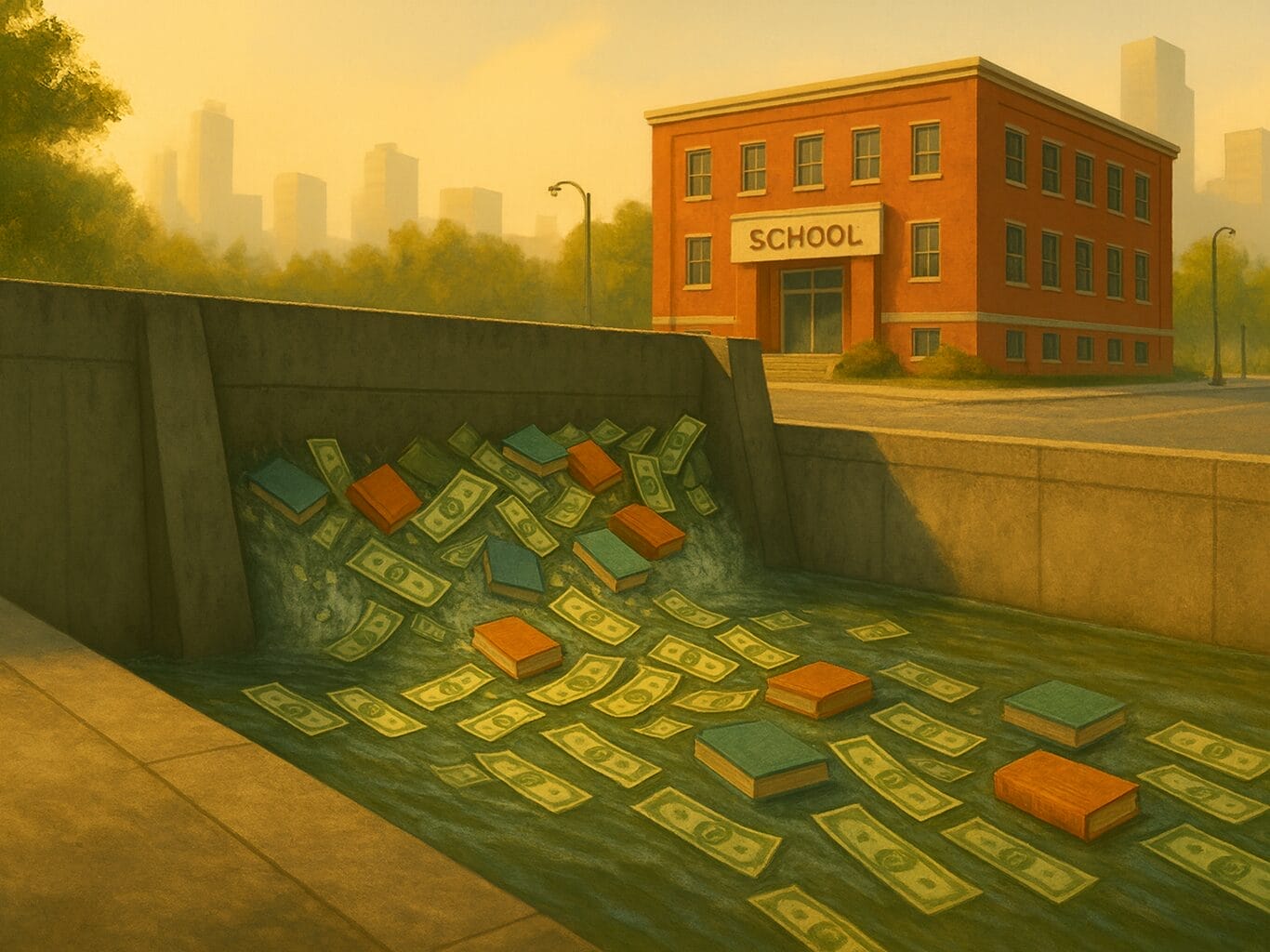This post originally appeared at https://www.badgerinstitute.org/tony-evers-puzzlingly-swift-rejection-of-more-education-money/
Could governor soften his view of new federal channel for donors’ generosity?

Why was Gov. Tony Evers so swift in rejecting a big stream of money from private donors for Wisconsin children’s education?
Evers spent his career in education and boasts of it. He likes being photographed in schools. He branded 2025 the “year of the kid.”
Yet asked the other day about whether he’d wave his hand to let Wisconsin taxpayers use a new federal tax credit for education-related donations, the governor slammed the door. He told a reporter it would be “catastrophic” for public schools, even though the new program allows donations to go to public school students for, say, tutoring, technology, books or other extra help.
Yet Evers said no. Why?
Evers’ rejection is early: Only four other governors have weighed in. A Republican in Tennessee and a Democrat in North Carolina opted their states into the program, and Democrats in Oregon and New Mexico opted out. Everyone else is still making up their mind.
“We have 15 months to discuss this before you absolutely have to make a decision,” said Dale Kooyenga, head of the Metropolitan Milwaukee Association of Commerce, a nonpartisan group that frequently weighs in on school reform. The tax credit — a dollar-for-dollar reduction in a taxpayer’s liability up to $1,700 — only starts in the 2026 tax year, meaning Wisconsin wouldn’t have to send Washington a list of approved “scholarship granting organizations,” through which Wisconsinites could send donations, until the start of 2027.
Kooyenga pointed out that while the program’s outlines in law are known, some details are hazy. How would families get scholarship money? Unknown. Can Wisconsinites get a credit for donating to organizations in states where governors said yes? Probably. Can an organization from another state set up an office in Wisconsin? Unclear, say Kooyenga and others.
That’s because while the law is passed, not a line of regulations to implement it has been written.
“It’s unfortunate a decision was made prior to getting all the details,” said Jim Bender, the Badger Institute’s education consultant.
What is known is that saying yes would bring Wisconsin extra money at zero cost to the state’s budget. From a state perspective, it’s all upside.
“It’s a game-changer,” said Kooyenga, with benefits for all sorts of kids. Scholarships could go not only to kids in public, charter or independent private schools, but also to cover homeschoolers’ education expenses. Scholarships could cover a broader range of costs than school choice, which covers just tuition and would remain unaffected — and could also benefit students in district schools.
And while Wisconsin’s existing parental choice programs outside Milwaukee are limited to families earning up to 220 percent of the federal poverty level, the new scholarships could go to children in households earning up to three times an area’s median income, looping in the upper middle class.
So why did Evers call this “catastrophic”? Was it raw politics? The legislation was tucked into the “One Big Beautiful Bill” broadly opposed by Democrats. Its inclusion of options beyond traditional district schools has run into objections with some governors who oppose school choice, and from public school unions.
Kooyenga notes the governor agreed with the Legislature two years ago on the largest increase in funding for charter and choice schools in history.
Much less money still accompanies a child going through the door of an independent school, and donations spurred by the federal credit could help that, said Kooyenga, but the miserable performance of Milwaukee Public Schools students in reading and math suggest they, too, could benefit from donor-funded extra help.
“This is this is a way that we were looking at investing more money in education,” he said.
It would be more money sent at donors’ discretion, not government’s, spent as parents see fit — funding the Congressional Budget Office estimated at about $3.7 billion a year nationwide, via what amounts to crowdfunding.
Meanwhile, 59 percent of parents told this summer’s edition of a venerable annual poll run by Phi Delta Kappa, the old-line teachers organization, that if they were given the public funding to do it, they’d send their kids to a private school. The result mirrored other polls nationally and in Wisconsin, and they suggest a tremendous pent-up demand by parents for something other than the local government-run school. You can see where interests would feel threatened.
Wisconsinites have 15 months for Evers to rediscover his open-mindedness about letting parents opt for what they really prefer.
“We’re optimistic that we could still talk to the governor, and we could work something out, and go from there,” said Kooyenga. So should we all be.
Patrick McIlheran is the Director of Policy at the Badger Institute.
Any use or reproduction of Badger Institute articles or photographs requires prior written permission. To request permission to post articles on a website or print copies for distribution, contact Badger Institute Marketing Director Matt Erdman at matt@badgerinstitute.org.
Submit a comment
#wpforms-55718.wpforms-block-0cf9c5de-772b-4409-8cd1-7422ecc159da {
–wpforms-button-background-color: #9e1b2f;
–wpforms-field-size-input-height: 43px;
–wpforms-field-size-input-spacing: 15px;
–wpforms-field-size-font-size: 16px;
–wpforms-field-size-line-height: 19px;
–wpforms-field-size-padding-h: 14px;
–wpforms-field-size-checkbox-size: 16px;
–wpforms-field-size-sublabel-spacing: 5px;
–wpforms-field-size-icon-size: 1;
–wpforms-label-size-font-size: 16px;
–wpforms-label-size-line-height: 19px;
–wpforms-label-size-sublabel-font-size: 14px;
–wpforms-label-size-sublabel-line-height: 17px;
–wpforms-button-size-font-size: 20px;
–wpforms-button-size-height: 48px;
–wpforms-button-size-padding-h: 20px;
–wpforms-button-size-margin-top: 15px;
–wpforms-container-shadow-size-box-shadow: none;
}
( function() {
const style = document.createElement( ‘style’ );
style.appendChild( document.createTextNode( ‘#wpforms-55718-field_5-container { position: absolute !important; overflow: hidden !important; display: inline !important; height: 1px !important; width: 1px !important; z-index: -1000 !important; padding: 0 !important; } #wpforms-55718-field_5-container input { visibility: hidden; } #wpforms-conversational-form-page #wpforms-55718-field_5-container label { counter-increment: none; }’ ) );
document.head.appendChild( style );
document.currentScript?.remove();
} )();
setTimeout(function(){var ct_input_name = “ct_checkjs_wpforms_71a3cb155f8dc89bf3d0365288219936”;if (document.getElementById(ct_input_name) !== null) {var ct_input_value = document.getElementById(ct_input_name).value;document.getElementById(ct_input_name).value = document.getElementById(ct_input_name).value.replace(ct_input_value, ‘168268029’);}}, 1000);
The post Tony Evers’ puzzlingly swift rejection of more education money appeared first on Badger Institute.
